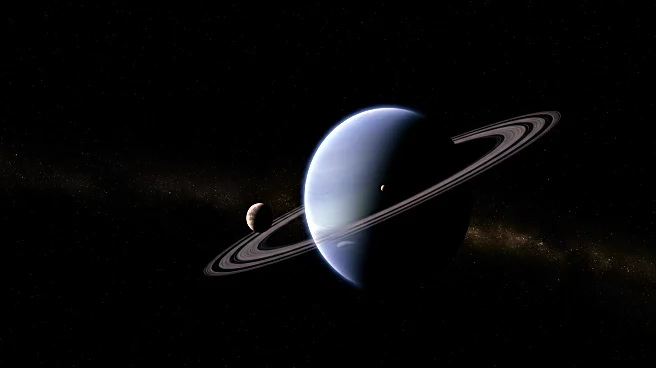What's Happening?
The James Webb Space Telescope (JWST) has identified a new moon orbiting Uranus, named S/2025 U1. This discovery was announced by researchers and the Central Bureau for Astronomical Telegrams, bringing the total number of Uranian moons to 29. The moon was detected using JWST's Near-Infrared Camera, which captured images on February 2nd, 2025. S/2025 U1 is a small celestial body, with a diameter similar to Mars' moon Phobos, and orbits Uranus every 9.6 hours. The discovery showcases JWST's ability to detect faint objects in the solar system, a feat not achieved by previous missions like Voyager 2.
Why It's Important?
The identification of S/2025 U1 underscores the James Webb Space Telescope's advanced capabilities in astronomical observation, particularly in the outer solar system. This discovery contributes to the understanding of Uranus' moon system and the dynamics of celestial bodies around gas giants. The ability to detect such small moons that were previously undetected highlights the potential for further discoveries, which could lead to new scientific insights and advancements in planetary science. The success of JWST in this endeavor demonstrates the importance of investing in cutting-edge space telescopes for future exploration.
What's Next?
Following the discovery of S/2025 U1, researchers may conduct further studies to understand its characteristics and its role within Uranus' moon system. The techniques developed for processing images to detect faint objects could be applied to other planetary systems, enhancing our knowledge of the solar system's dynamics. Additionally, the International Astronomical Union may propose a formal name for the moon, continuing the tradition of naming Uranian moons after characters from Shakespeare and Alexander Pope.
Beyond the Headlines
The discovery of S/2025 U1 raises questions about the naming conventions for Uranian moons, which traditionally draw from literary characters. The success of JWST in detecting such faint objects underscores the importance of investing in advanced space telescopes for future astronomical research. This discovery also highlights the potential for JWST to uncover more unknown moons or celestial phenomena, contributing to the broader understanding of the solar system.

